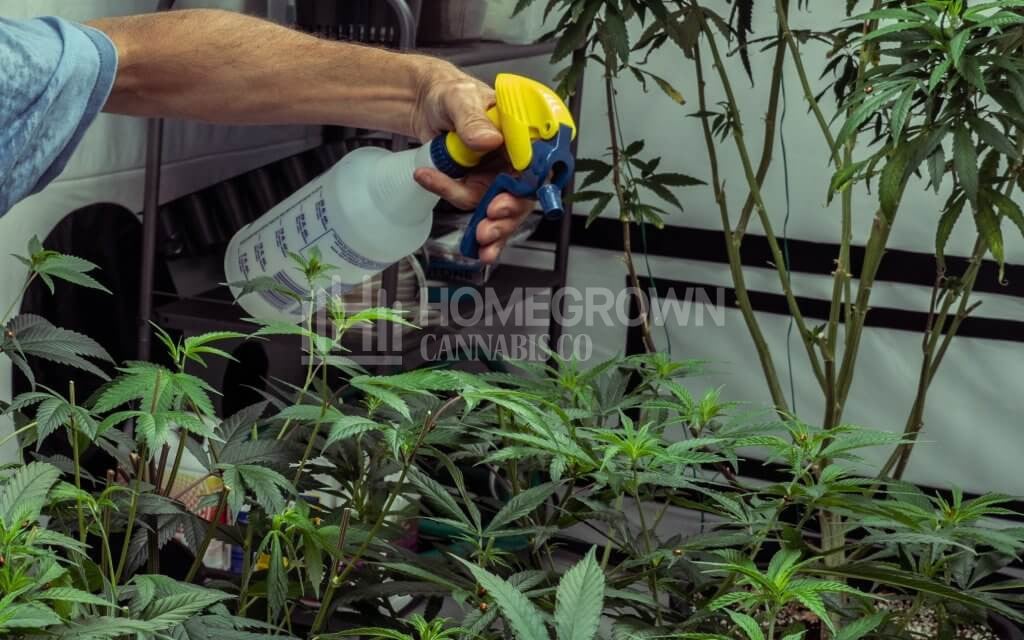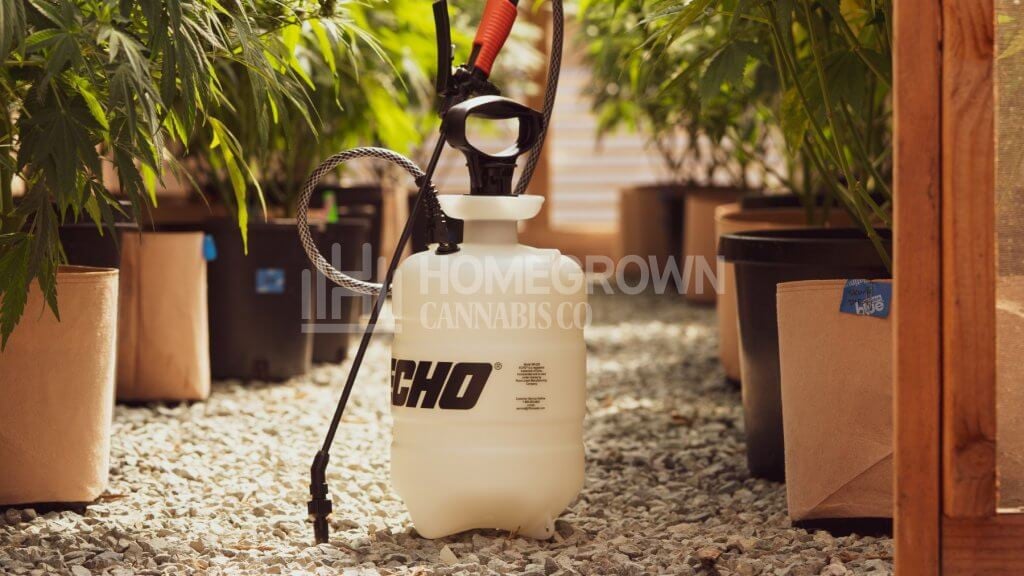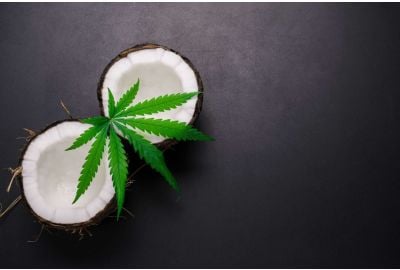Learning How To Foliar Feed Cannabis
Do you want to know how to foliar feed cannabis and increase your chances of getting exceptional yields? You might be unfamiliar with the technique since most people believe that marijuana plants get all the nutrients they need from their roots. This is mostly true.
Marijuana crops get their nourishment as most plants do. Their leaves and roots are the principal means to absorb everything they need and release waste. When you use foliar spray on cannabis plants, you're optimizing that process.
Foliar spraying cannabis is a fantastic way to feed extra nutrients to your weed plants. It's also a great method to deal with cannabis pests and mold using proper insecticides or fungicides products. The secret's in the leaves since they absorb everything you spray in them. Let’s take a closer look.

What is foliar feeding for marijuana?
Foliar feeding marijuana means spraying a liquid mixture directly on the leaves of your plants. The combination can be either a fertilizer or pesticide. With foliar feeding, you provide nutrients to your weed using its leaves instead of letting the roots do all the work.
Foliar spraying cannabis is a widely used care method for marijuana gardens since it brings many benefits. This technique feeds nutrients directly to weed plants via the stomata, an opening between two guard cells.
A regularly scheduled spray for weed plants stimulates the stomata, making guard cells stronger in the process. You have to be careful with the timing of this procedure, or you risk overfeeding your plant.
What are the benefits of cannabis foliar spray?
Foliar feeding marijuana brings a lot to the growth process, from making the nutrient intake easier to mitigating stress. There are plenty of advantages with this feeding method if done correctly. Let's take a look at some of the most well-documented benefits:
Optimizing nutrients intake
If you choose to foliar feed cannabis plants with nutrients, they increase their chances of offering a better yield. Scientific studies have reported how this method of feeding nutes to weed plants increases their prospects of a successful harvest up to five times.
Stress releaser
Did you know your plants get stressed? The whole process of making sure nutrients reach every inch can be very strenuous. Your plants risk becoming hermaphrodites in the process. By foliar feeding marijuana, you´re helping them get everything they need.
Your plant won’t have to scrape for nutrients at the roots, avoiding stress in the process.
You help nutrients reach every cell of the plant
Foliar feeding cannabis plants means you're giving your weed the chance to get nutrients to reach every single part of their cellular structure. Cannabis roots can soak up a lot of nutes, but not all of them get to every cell of the crop.
It makes the root's job easier
Roots are the ultimate multitaskers in any weed plant. Their primary function is absorbing nutrients from the soil and processing them. Foliar spraying cannabis gives the plant a better intake of carbohydrates to feed the microbes that help the crop’s functions run as they should.
You avoid mineral accumulation
When you foliar spray cannabis, the overall intake of minerals in your plant gets balanced. This is great to avoid the accumulation of salts and nutes in the root's structure. The leaves play a more prominent role in absorbing food, releasing the roots of some of this responsibility in the process, and avoiding a nutrient lockout.

When is the right time for foliar spray cannabis?
By now, you must be wondering when's the best time to foliar feed your marijuana plants. You won't need to spray anything on your garden until all plants reach a vegetative state. If you try to foliar feed them nutrients as they develop, you risk contaminating the buds.
The sole exception to this rule is when you notice nutrient deficiencies in your plants. The most common issues at this stage are a lack of calcium, nitrogen, or magnesium. The best you can do is prepare a small portion of spray for weed plants and apply it just once to the affected region.
If you keep a steady schedule and foliar feed cannabis during the vegetative stage, your plants will make better use of all the macronutrients provided. The best time to apply the spray when you’re growing outside is during the morning time.
If you're growing indoors, the best time to foliar feed your weed plant is right after turning the lights on in the setup. Be mindful of the temperature as well. Keep in mind that indoor light intensity increases the room's temperature. The temp should be no higher than 26°C. The solution on the leaves reflects the light, just like a magnifying glass.
This can be a little tricky if you’re spraying pesticides. Too much solution and you risk burning the plant instead.
Is it ok to foliar spray during flowering?
In a nutshell: no. Foliar feeding during the flowering stage isn’t advised. When your weed plants reach this phase, they’ll secrete resin to create an insulated environment to keep themselves at the best temperature to thrive.
The only way you should use foliar feeding during flowering is in a controlled environment. You have to lower the room's temperature while you spray, and you can only do it for two weeks maximum. Otherwise, you'll get weird-tasting weed and smoke with nutrient residuals.
How often do you have to foliar feed your plants?
You know when, but you don’t know how often to foliar feed your weed plants. Many canna-gardeners out there agree that the frequency should be at least once a week.
Before creating a schedule to foliar spray your cannabis garden, remember that leaves on your plant absorb anything sprayed on them quicker than they do via the roots. Traditional feeding via the roots takes up to 24 hours to stimulate your garden. Foliar feeding takes much less.
Your foliar feed cannabis schedule depends on your setup. Let’s take a look at the difference when you grow in or outdoors.
When you grow outdoors:
Early morning is the way to go, right before the sun rises. When you foliar spray cannabis during these hours, you avoid the intense sun, and your plants soak up all the nutrients before the hottest hours of the day.
You can foliar spray your marijuana garden in the evening, but you should only do it if the climate favors the plant’s ideal environment. Spraying weed on a cold night is a recipe for disaster.
When you grow indoors:
You can begin to foliar feed cannabis plants before turning on the lights in your setup. That way, the solution gets absorbed by the plants as the lights increase their heating intensity.
Unlike outdoor gardens, foliar feeding cannabis plants in the evening before turning off the lights isn’t a good strategy. Your lamps regulate much of the temperature in the room and leaving your plants sprayed in the dark will backfire.
How to foliar feed cannabis plants?
Now you’re going to learn how to foliar feed your marijuana plants with an easy recipe. Before we get started, make sure to collect the following tools:
- Spray bottle
- pH neutral water
- pH/nutrient meter
- Basic container
- Nutrients (or natural pesticides)
Do your best to secure a glass spraying bottle. If you can’t, make sure your spray bottle is pristine-clean before using it. If you have all the tools, it's time to foliar feed your cannabis plants. Make sure to follow these steps:
Mix your spray for weed plants
Using the container, you need to mix 5ml of nutrients for every liter of water. Make sure to check the instructions of the cannabis nutrients you’re using and how much is required by the strain you’re growing.
Check pH and nutrient content
Use your ph/nutrient meter to check the values of the mix you've made. Nutrients are measured in PPM/EC. A good foliar spray cannabis solution should have a 5.7 pH level and no more than 500 PPM/EC.
Start spraying
Now it's time to spray those nutrients onto the cannabis leaves. Make sure to set the nozzle to "spray" and add a light mist gently from top to bottom. Do this once a week, and that's it! Don't drench your plants to the point of drowning them, and don't forget the undersides.
A note about pesticides
We've mentioned how you can foliar feed cannabis plants with pesticides using the same procedure as nutrients. When it comes to mixing water with the pesticide, you need to use the exact measurements. The pH level of the mix should be no lower than 5.0 and no higher than 7.0.

What should you avoid when foliar spraying cannabis?
So far, we've learned the benefits and how to foliar feed your weed garden. The bad news is that there's also plenty of risks and parts that could go wrong. Fear not! Let’s talk about what you need to avoid to get the best results possible.
Don't foliar spray cannabis with lights on or under direct sunlight
Liquids act just like a lens under light. They amplify the heat from any source. If you foliar feed weed under direct light, you'll burn the leaves. The heat also chokes the plant by disrupting the functions of the stomata.
Avoid foliar feeding cannabis in a humid environment
Foliar feeding cannabis increases humidity within the plants and the environment. If your marijuana plants have reached the flowering stage, the moisture increases even more. If you foliar feed cannabis at this phase, you'll only encourage mold.
Avoid exceeding the concentration of nutrients
The dilution ratio of nutrients is critical. Practice due diligence, as some strains are very delicate in this regard. Make sure to stick to the instructions on the store-bought fertilizer, or you could cause a nutrient lockout.
Use natural alternatives to chemicals for pesticides or fungicides
Avoid using chemical pesticides for your cannabis foliar spray mix, as some have been reported to include harmful ingredients that can poison you. They also damage the plant and can make your weed taste funny.
If you have to deal with mold or pests, use a natural foliar spray on your cannabis plants to contain the issue. You’ll be doing your plants a big favor by avoiding chemical agents.
We recommend you go natural using neem oil, Aloe Vera juice, an emulsified mix of potassium silicate and a homemade fungicide. This foliar spray for cannabis works wonders to repel pests in record time; the best part is that you only need to apply it once a week.
What is the best foliar spray for cannabis?
Many growers believe foliar feeding works the same with all marijuana plants. It doesn't, and we’re going to explain why. Here are some facts you should know to make the best mix spray for the weed plants in your garden:
- Work with pH-neutral water or distilled water. It's the cleanest water you can find and the one with the proper nutrients for marijuana plants. If you foliar feed cannabis with tap water, you'll be adding unrequired minerals to your crops and could cause further issues.
- Temperature plays a significant role when you foliar spray cannabis plants. The water should be above 23°C, never below it. Also, make sure the room temperature is in line with the water you're using. Your plants will become stressed if they suddenly get showered with colder water.
- Use a surfactant in your cannabis foliar spray mix. This increases the penetrating power of the nutrients on the leaves. Make sure your nute mix also includes some silica for cannabis. This ingredient makes your plants resistant to pests and diseases.
- If you need to use a single pesticide, potassium soap should be your first choice. Not only does this natural substance get rid of pests on contact, but it also protects the plants against future attacks. If you mix it with neem oil, its effects increase tenfold.
There's no definitive answer stating which is the best foliar spray for cannabis. All weed plants grow differently, and they need a different set of nutrients and care. The environment where they grow also determines how frequently you should get to foliar feed your cannabis plants.

FAQs
Here are some of the most commonly asked questions about foliar feeding marijuana:
Can you foliar feed with molasses?
Sure, you can! Make sure to dissolve a teaspoon of molasses in a gallon of water before preparing the mix to foliar spray cannabis. By spraying the solution on the undersides of the leaves, you'll be nourishing the plant while protecting it against pests.
How fast does foliar feeding work?
When you foliar feed cannabis, it takes the plant at least 12 hours to absorb the nutrients completely. You can see the effects over a week before it's time to respray them. If you use pesticides, you should see the effect almost instantly.
Does pH matter when foliar feeding weed?
Definitely. pH plays a crucial role when you measure the acidity of the water and the nutrients that go into the plant. The pH level for weed ranges from 5.0 to 7.0 max, depending on the strain.
Can foliar feed burn plants?
Yes, it can. The schedule and how you foliar spray cannabis plays a big role in the effect it has on the plants. If you spray your weed plants under direct sunlight or when the lights are on, the water reflects the light and burns the leaves.
Can I use foliar fertilizer on soil?
It’s best to use this technique just for the plants. Foliar feeding cannabis is a complement procedure to the regular feeding schedule of your plants and isn’t a substitute to regular weed fertilizer. Foliar spraying is also used when dealing with mold or pests. It can never substitute traditional irrigation or nutrient intake.
What is the best time to foliar feed your weed plants?
The best time to foliar feed weed plants depends on your setup. We recommend you spray your marijuana plants right before the sun rises if you're growing outdoors. If you have an indoor setting, you should spray your plants before turning on the lights.

Give your plants a little boost
We’re sure you now have a clear picture of how helpful foliar feeding cannabis can be. By getting the right tools and using the right mix of nutrients, you'll be able to help your weed plants achieve their maximum potential.
Now you need to figure out how often you have to foliar feed cannabis plants depending on your setup. Getting the timing right is crucial if you want a bigger harvest.
Remember, there’s no fixed recipe for choosing the best foliar spray for cannabis plants. You can learn more about this topic and other growing techniques on the Homegrown Cannabis Co. Forum.
You'll find interesting takes on spraying schedules, mix recipes, strains, and other experiences from many growers, as well as our resident expert Kyle Kushman.
About the author: Parker Curtis
Parker Curtis has around a decade of cannabis-growing experience, specialising in soil-less and hydro grows. He’s mastering outdoor, greenhouse, and indoor grows.


